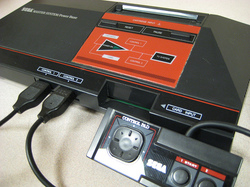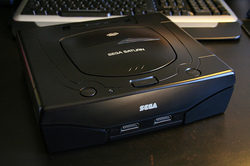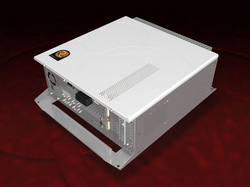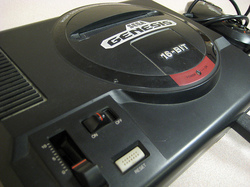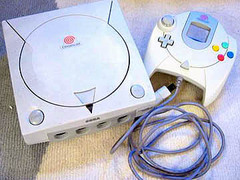Sega Corporation (株式会社セガ)
"Seeegaaaa"
Sega Master System
The Master System's CPU is a 8/16-bit Zilog Z80. The maximum addressable memory is 64 KB.
Video:
Graphics: VDP (Video Display Processor) derived from Texas Instruments TMS9918A
Up to 32 simultaneous colors available (one 16-color palette for sprites or background, an additional 16-color palette for background only) from a palette of 64 (can also show 64 simultaneous colors using programming tricks)
Screen resolutions 256×192 and 256×224. PAL/SECAM also supports 256×240
8×8 pixel characters, max 463 (due to VRAM space limitation)
8×8 or 8×16 pixel sprites, max 64
Horizontal, vertical, and partial screen scrolling
Audio:
Sound: (PSG): Texas Instruments SN76489 (note that the Sega Master System, Game Gear, and Mega Drive used a slightly altered clone of the newer SN76489A, while the older SG-series used the original SN76489)
4 channel mono sound (3 Square Waves, 1 White noise)
3 tone generators, 10 octaves each, 1 white noise generator
Sound (FM): Yamaha YM2413
Mono FM synthesis
Switchable between 9 tone channels or 6 tone channels + 5 percussion channels
Included as a built-in "accessory" with the Japanese Master System (1987)
Supported by certain games only
Onboard RAM:
Boot ROM: 64 kbit (8 KB) to 2048 kbit (256 KB), depending on built-in game
Main RAM: 64 kbit (8 KB), can be supplemented by game cartridges
Video RAM: 128 kbit (16 KB)
Game Card slot (not available in the Master System II)
Game Cartridge slot (not included on newer Brazilian models, as these have built-in games)
Japanese and South Korean consoles used 44-pin cartridges, the same shape as SG-1000 cartridges
All other consoles use 50-pin cartridges[25] with a wider shape
The difference in cartridge style is a form of regional lockout
Expansion slot:
Unused, pinout compatible with 50-pin cartridges (but opposite gender) in all regions
Dimensions:
Width: 365 mm
Depth: 170 mm
Height: 69 mm
Media:
1 cartridge port
1 Game Card slot (Mark III and Master System 1 only)
2 controller ports
AV port and internal RF adapter
Sega Saturn
CPU: 2 x 32-Bit RISC SH2 at 28.6 MHz, 32-Bit RISC SH1 at 20 MHz. 25MIPS
Memory: 16 Mbit Work RAM, 4 Mbit Audio RAM, 256 Kbit Backup RAM, 12 Mbit Video RAM, 4 Mbit CD Buffer RAM, 4 Mbit IPL ROM.
Sound: 16-Bit CISC 68EC000 (11.3 MHz), PCM & FM sound sources, 32 channels, 16-Bit Sampling, Sampling rate 44.1 KHz max, Audio DSP
Graphics: 16.77 Million Colours Sprite Enlargement, Reduction, Rotation, Transformation
CG Capability: Polygon Specialized Hardware Texture Mapping, Flat Shading, Gouraud Shading, Wire Frame
Scroll: 5 Screens (Scaling, rotating, enlargement, reduction)
2D Graphical Capabilities: VDP1 processor handling sprites, polygons and geometry VDP2, processor handling backgrounds, 5 simultaneous planes with two rotation planes, 32,000 colours from 24-bit palette.
CD Drive: Intelligent 2x. Data Transfer Rate (DMA to RAM), 150 KB/sec. (Normal), 300 KB/sec. (Double speed), Maximum Capacity - 660 Megabytes, Audio CD play with reactive display, CD+G compatible, CD+EG compatible, CD Single compatible, Photo CD compatible, Video CD compatible and Ebook compatible
Sega Ringedge
Intel Pentium E2160 CPU @ 1.8 GHz
1GB of DDR2 PC2-6400 RAM
An “nVidia GPU” w/ 384MB of GDDR3 RAM and supports Shader Model 4.0 and “two 1920×1200″ which probably means it has ports for two monitors and can support up to that resolution. Also as of a note, it says “nVidia GPU 2″ on the document up higher – not sure if that means
5.1 ch HD Audio
Onboard Gigabit LAN
A 32GB SSD drive for storage (finally, flash storage instead of a standard HDD which will likely fail soon)
Microsoft Windows Embedded Standard 2009
ALL.Net
Sega Genesis
Processor: Motorola 68000 16/32-bit processor running at 7.67 MHz
Co-processor (Sound Controller): Zilog Z80 8-bit at 3.58 MHz
Video Display Processor: Yamaha YM7101, derivative of the VDP from the Sega Master System
Memory: 64K work RAM (68000), 64K video RAM, 8K work RAM (Z80)
Later hardware had an internal 1Kx16 ROM for the license display screen.
Display Palette: 512 colors (3:3:3 RGB)
Onscreen colors: 64 (normal) or 183 (shadow/highlight mode)
Maximum onscreen sprites: 80 (320-pixel wide displays) or 64 (256-pixel wide displays)
Resolution: 256×224, 256×448, 320×224, 320×448, (PAL and NTSC)
256×240, 320×240, 256×480, 320×480 (PAL only), 256×192 (SMS games only)
Sound: Yamaha YM2612 5 channel FM and 1 channel FM/PCM, Texas Instruments SN76489 4 channel PSG (Programmable Sound Generator)
Media: 1 sidecar expansion slot, 1 cartridge port, 2 joystick ports, AV port
Backwards compatible with all Sega Master System games using converter
Sega Dreamcast
CPU speed: 200MHz
RAM: 26 Megabyte (16MB main/8MB video/2 MB sound)
Sound: 64 Voice Yamaha Super Intelligent Sound Processor (45MHz, 40Mips, 64 voices, 16-bit 48KHz, 3D audio support)
Graphics processor: NEC PowerVR Series II (100MHz, renders up to 3.5 million polygons/sec)
MIPS: 360 Mips
FLOPS: 1.4 Billion
Polygons per second: 3 Million
CD-ROM Drive: 12 speed Proprietary Yamaha GD-ROM (Gigabyte Disc)
Stores up to 1.2 Gigabytes.
Controller ports: 4
Dimensions: 189mm x 195mm x 76mm (7 7/16" x 7 11/16" x 3")
Weight: 1.9kg (4.4lbs)
Internal Modem: Broadband/Ethernet Capability
Sega Ringwide
An Intel Celeron 440 @ 2 GHz
1GB of DDR2 PC5300 RAM
“AMD GPU” with 128MB of GDDR3 RAM, supports Shader Model 4.0 and also has two ports to handle 1920×1200 resolution video
5.1 ch HD Audio
Onboard gigabit LAN
An 8GB Compact Flash for storage
Microsoft Windows Embedded Standard 2009
ALL.Net
